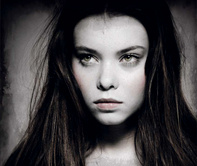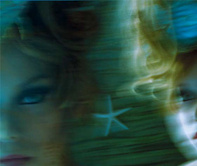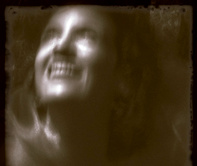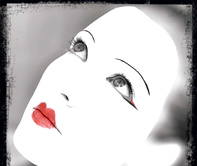
ELLA MANOR - INNER APPARITIONS BY LARRY BROWNSTEIN
When Ella Manor was preparing to return to her native israel to get married, she not only considered the changes that marriage would entail, she also set up a photo shoot: a self-portrait in which she could explore her feelings. In the picture, despite her face being mostly obscured by a veil, she’s lost in thought, pondering how her life will change.
She recalls the various feelings she was experiencing and the sense that her life was both ending and beginning. The inner drama compelled her to take pictures to express these feelings. Much of her fine art photography comes from similar impulses to express her inner state—and the feelings, conflicts and desires that present themselves to her, if but vaguely formed.
Ella has been a painter since elementary school and began studying art history and graphic design in high school, where she was introduced to photography. she was struck by its magic, particularly that of the darkroom. while studying at the Fashion institute of technology in new york City, ella took a course in digital photography with a teacher, Curtis Willocks, who inspired her. “[i began] shooting like crazy, like my life depended on it,” she relates with a laugh. now, she shoots fashion and lifestyle as well as her fine art personal work.
while personal photography is a medium that allows Ella to explore her life and psyche, she is cautious to not analyze the whole process too much. still, she grants that her images do reveal aspects of her personality and elements of her life in an artistic and intuitive way. This expression in and of itself seems to be enough for her and she sees little need to critique it, whether before, during or after the shoot. intellectualizing art may be in vogue, so to speak, but Ella believes it can be a counter- productive process.That said, she also avoids excessive planning in her personal work as, in her experience, it is at odds with her goal of spontaneously expressing herself. as a good example of this, she discusses “The Dance of Life” series in which she photographed herself dancing with a skeleton. The genesis of the series was quite simple: Ella came across the skeleton in a class- room and found it piqued her interest.
Even though a part of her will usually second guess her initial impulse, she ignored the considerations that invariably followed in this case. Ella trained herself not to al- low logical questions, such as, “who will want to see pictures of me and a skeleton?” derail her.
As it did for this series, her background in art history often influences Ella’s work. she appreciates edvard Munch’s work, including his iconic painting “The scream.” she was also aware of a lesser known Munch painting from which she took the title of the series. in the painting Munch depicts several couples dancing, yet it is far from a festive scene: to the left a figure in white suggests youthful innocence, while in the center a couple dances without enthusiasm, seemingly unaware of the dark, withered figure standing to their right. Ella played with similar dynamics by posing herself dancing with a skeleton. She then partially solarized the image using digital effects, making it appear less like a photo by manipulating its mood, the result is very painterly.
When we look at her series called “Gordon inn Blue” (see above, bottom left) she recounts traveling to her native israel and encountering a hotel building she had walked by many times as a child. When she saw it on her recent trip it had been abandoned for many years and was decaying. She found her way in through a window, discovered rooms painted in shades of blue, and was drawn to the charred ruins of what had once been a lively bar. There was a blue wall, the color was streaked as a result of a fire. “it was a little creepy but it was so beautiful,” she says. Ella took self-portraits there, moving during the long exposures.
“They are partially abstract depictions of myself and they symbolize the layers of who I am, who I would like to be and who I am afraid to be, and they all come together at one time to display the possibilities of me,” she says. “I believe a person’s identity is multifaceted, determined by genetics, temperament, societal influences and personal judgment.”
In yet another series in which she depicts herself as a geisha girl (pg. 32), Ella explores the role of women as objects and how makeup is used as a mask to project an image to the world. she says these photos are inspired by the work of Kimiko Yoshida, who did a series depicting herself as a bride in various cultures.
The lyrical, evocative quality of Ella’s photos results from a combination of her visceral working style and her experiments with digital filters and mixing media.
“I work intuitively,” she says. “I try not to plan the details of my shoot in advance or over-think them because I know that if i do, I lose their raw quality.” While she appreciates the convenience and economy of shooting digitally, Ella prefers a more organic feeling for her images. “That’s how I started looking for ways to make my digital images look like film. Using various plug-ins, I can control the size of the grain, the roughness of it, the amount of grain I have in the highlights, the shadows and the mid-tones separately. i can simulate cross-processing, push-processing, polaroid film, and all this gives a tremendous amount of freedom and control over my work.”Many of Ella’s images appear to have been solarized—a technique discovered by Man ray. Numerous images have a large, grainy quality leading one to think that the photos were taken with tMaX 3200 or some other high-speed black-and- white film. others have a blotchy quality that evokes the quality of a polaroid image transfer in which not all of the emulsion transfers successfully to the substrate, leaving random black patches. still others have interesting edge effects that suggest the use of polaroid sheet film while her toning effects suggest platinum prints or selenium toning.




